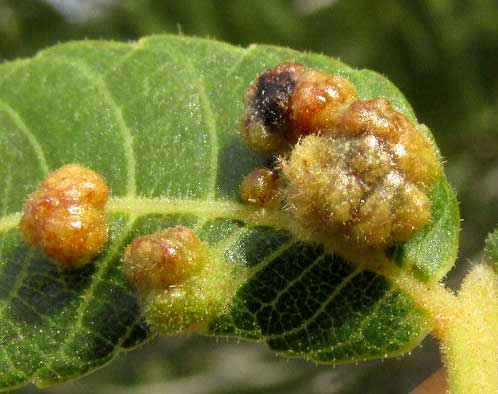Excerpts from Jim Conrad's
Naturalist Newsletter

from the August 17, 2014 Newsletter issued from the Frio Canyon Nature Education Center in the valley of the Dry Frio River in northern Uvalde County, southwestern Texas, on the southern border of the Edwards Plateau; elevation ~1750m (~5750 ft); N29.62°, W99.86°; USA
WALNUT WART GALL
Nowadays warty-looking galls are turning up on the leaves of several plant species. Above, you can see some on the leaflets of our Little Walnut, Juglans microcarpa, a common small tree along the Dry Frio River.
A closer look, showing that the small galls are covered with hairlike trichomes, appears below:

It can be hard to identify the agents that cause particular kinds of galls to form. However, often the organisms causing galls restrict their activities to just one or a few species of host plants. Keeping that in mind, and noticing that these galls resemble warts, on the Internet I did an image search on the keywords "gall walnut wart," and within seconds was presented with pictures matching ours. They were attributed to "Walnut Gall Mites," Eriophyes erinea. Unfortunately, all the matching pictures were taken in Europe and I find no reference to Eriophyes erinea occurring in the Americas.
Still, it's a good guess that our Little Walnut's warty galls are caused by mites in the same family at Eriophyes erinea, and that's the Eriophyid mite Family, the Eriophyidae. Since we're talking mites here, we're referring to arachnids, like spiders, not insects.
The Eriophyid Mite Family is huge, with more than 200 genera and 3600 known species, but it's estimated that these known species account for only about 10% of the world's actual number. The family is poorly studied, so it's entirely possible that our galls on a walnut species found only in the US south-central states and northeastern Mexico might be caused by a mite unknown to science, or at least poorly documented.
Members of the Eriophyid Mite Family are microscopic, and yellow to pinkish white to purplish in color. I think of mites as looking like tiny spiders, but Eriophyid mites are worm-like or cigar-shaped, with only two pairs of legs (most mites have four pairs). They're so small that they disperse mainly on the wind. They occur on a wide range of plants, and several species cause serious crop damage. Most species are very host-specific -- so you wouldn't expect to find a single species forming galls on both walnut and apple trees.
Eriophyid mites feed deep within a plant's tissues, sucking out plant juices. As they feed, they introduce into the plant tissue a toxin that causes deformation of plant growth -- a tumor-like gall.
On the Internet I find galls looking like ours produced by the Eriphyid genus Aceria, of which over 900 species are known, many of which occur in the US. Otherwise, I can't say much more of the warty galls on our local Little Walnuts than that they appear to be caused by Eriophyid mites.
Still, I bet that someday a specialist will be tickled to see our documentation, and maybe he or she will write, saying exactly what we have here.